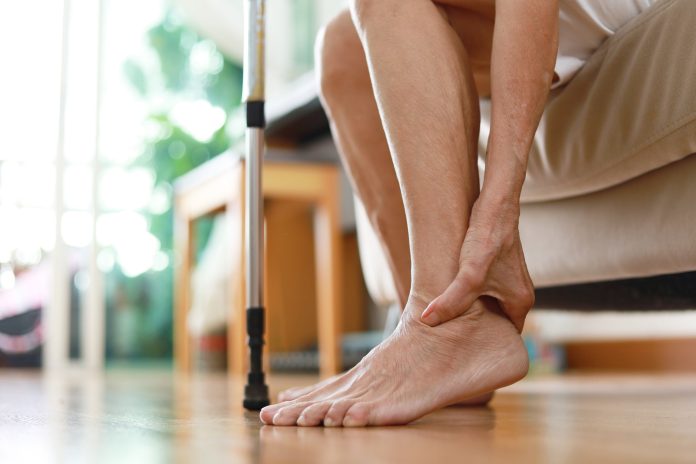Regular foot check-ups are critical for mitigating foot problems in people with diabetes; Lorna Rothery spoke to the podiatry team at Mid Yorkshire Teaching Hospital about the risk factors for and prevention of diabetic foot problems
Diabetes, when poorly controlled, can lead to foot problems due to risk factors such as peripheral arterial disease, neuropathy, and retinopathy. Individuals with a history of foot ulceration are particularly susceptible to developing further foot issues. A common issue is the lack of awareness about the potential impact of diabetes on the feet. Some patients, unable to feel their feet, may wear shoes or socks that are too tight, leading to blisters and additional complications. Additionally, using hot water bottles and wheat bags to relieve perceived coldness in the feet can actually cause skin damage.
It’s important to categorise the risk factors for foot problems in people with diabetes into different sections. Patient- related factors include the duration and control of diabetes, as well as the presence of neuropathy and peripheral arterial disease. Men have a slightly higher prevalence of foot ulceration than women, possibly due to differences in foot care and occupation. Smoking is also a significant risk factor for developing arterial disease and foot problems.
Many patients tend to neglect their feet due to competing priorities, such as child care and demanding jobs. Furthermore, foot ulceration is associated with socio-economic status, with individuals in less affluent areas being more prone to developing foot ulcers.
Foot ulceration not only adds to the burden of chronic diseases but also causes feelings of depression and frustration among patients. This, in turn, can lead to self-neglect, impacting both foot care and diabetes management. Older individuals are also at higher risk, as age increases the likelihood of trauma, falling,
and developing diabetes-related complications.
How can diabetic foot problems affect people’s quality of life?
Someone with a foot ulcer will need to visit the foot clinic almost every week, possibly spending extended periods in hospital and taking frequent antibiotics that can have side effects. As a result, they may be unable to work, face stigma due to their condition, and may need to wear special footwear or have undergone amputation. Some may not get sick pay and can even lose their jobs, leading to a strain on their relationships.
Podiatrists provide crucial support and information, but it’s important to recognise the broader negative impact of foot ulceration on people’s lives, including the economic, social, and psychological repercussions. These aspects should not be overlooked, as they’re highly significant for patients.
Can you outline the key challenges that healthcare professionals currently face when treating diabetic foot problems?
For healthcare professionals, a significant challenge is that our patients usually require frequent courses of antibiotics. If bacteria develop resistance to antibiotics, it becomes increasingly difficult to treat infections. This leads to the need for more complex treatment regimens and even hospitalisation in some cases. Antibiotics can have other serious side effects, such as abnormalities in liver function and interactions with other medications. Older and frail patients often experience side effects such as diarrhoea, nausea, vomiting, dehydration, and an overall deterioration in health due to antibiotic use. These challenges highlight the significant issue of antimicrobial resistance in healthcare.
The guidelines are clear that a patient with a diabetic foot ulcer should be referred within 24 hours. However, we still encounter issues where people are unaware of the urgency of foot ulcers and are unsure where to seek care. Despite spending a lot of time emphasising this, we still receive referrals late, or patients are sent elsewhere before ending up with us, resulting in treatment delays.
Compliance is a major issue with many of our patients. When we discuss the possibility of amputation, many of them seem to think it won’t happen to them.
What can be done to minimise the risk of foot problems worsening? Can you provide some examples of good practices in clinical infection prevention protocols?
When discussing the prevention of infection, diabetic foot ulcers are different from regular infections caused by a virus. Rather than being acquired from the environment, they result from a breakdown in the body’s natural defence system. Bacteria present on the wound’s surface can turn harmful and lead to a deep-seated infection within the tissues. It’s uncommon for this type of infection to spread from one person to another. However, there are hospital-acquired infections, such as MRSA, which are managed using specific protocols and antibiotics.
International guidelines, UK guidelines, and local guidelines are available. The local guidelines are crucial because they are based on current bacterial sensitivity in the area and developed in collaboration with microbiologists and infection control experts who are well-informed about the most effective antibiotics for the bacteria present. This is how we handle infections within the secondary care setting; we have unified protocols in place to ensure consistent care.
Sometimes, patients prefer to perform their dressing changes at home for various reasons. In these cases, we make arrangements for them to comfortably handle the dressing changes at home. It’s important to provide clear instructions and guidance, especially in a clinical environment. We’re not aware of the conditions in which patients are changing dressings at home, so it’s crucial to provide clear advice and the necessary dressing equipment to minimise the risk of infection.
What are the key issues that need to be addressed regarding the prevention of diabetic foot problems?
Awareness is key. Podiatrists stress the importance of patient education, particularly regarding foot care vigilance. This includes being mindful of the footwear individuals choose; they need to consider whether the shoes are suitable, especially if they have complications like neuropathy. We aim to provide as much education as possible, but there’s often an information overload. They might want a nice pair of shoes or heels for an event, and when these situations arise, we sometimes have to remind them of the risk factors. Some people return from vacation having walked barefoot and lost sensation in their feet. It only takes a short amount of time before they realise that the ground is too hot and they have burned the soles of their feet, in which case they should try and see us within 24 hours.
We have a recall system where patients are sent a letter to remind them to schedule a foot check-up after they have received treatment. This practice has been in place for the past few years. It’s important because it serves as a reminder for patients who may otherwise forget to attend a foot check-up.
The simplest thing patients can do is check their feet regularly. Even if we schedule recalls for four, six, or eight weeks, anything can happen in that time. Patients should check their feet and shoes daily and know who to contact if they have a problem. It’s crucial for GP practices to understand that diabetic foot problems are time-sensitive and to promptly refer patients to us when needed. Patients also need to optimise their blood sugars, as many don’t realise the link between high blood sugars and complications. It’s essential to educate them about this connection.
Equally, we would encourage patients’ participation in research, as it’s crucial for the development of our speciality and understanding of the condition. Increasing awareness of the condition and paying attention to foot health is essential.
Mid Yorkshire Teaching Hospital Podiatry Team
Website
LinkedIn
Twitter
Facebook








